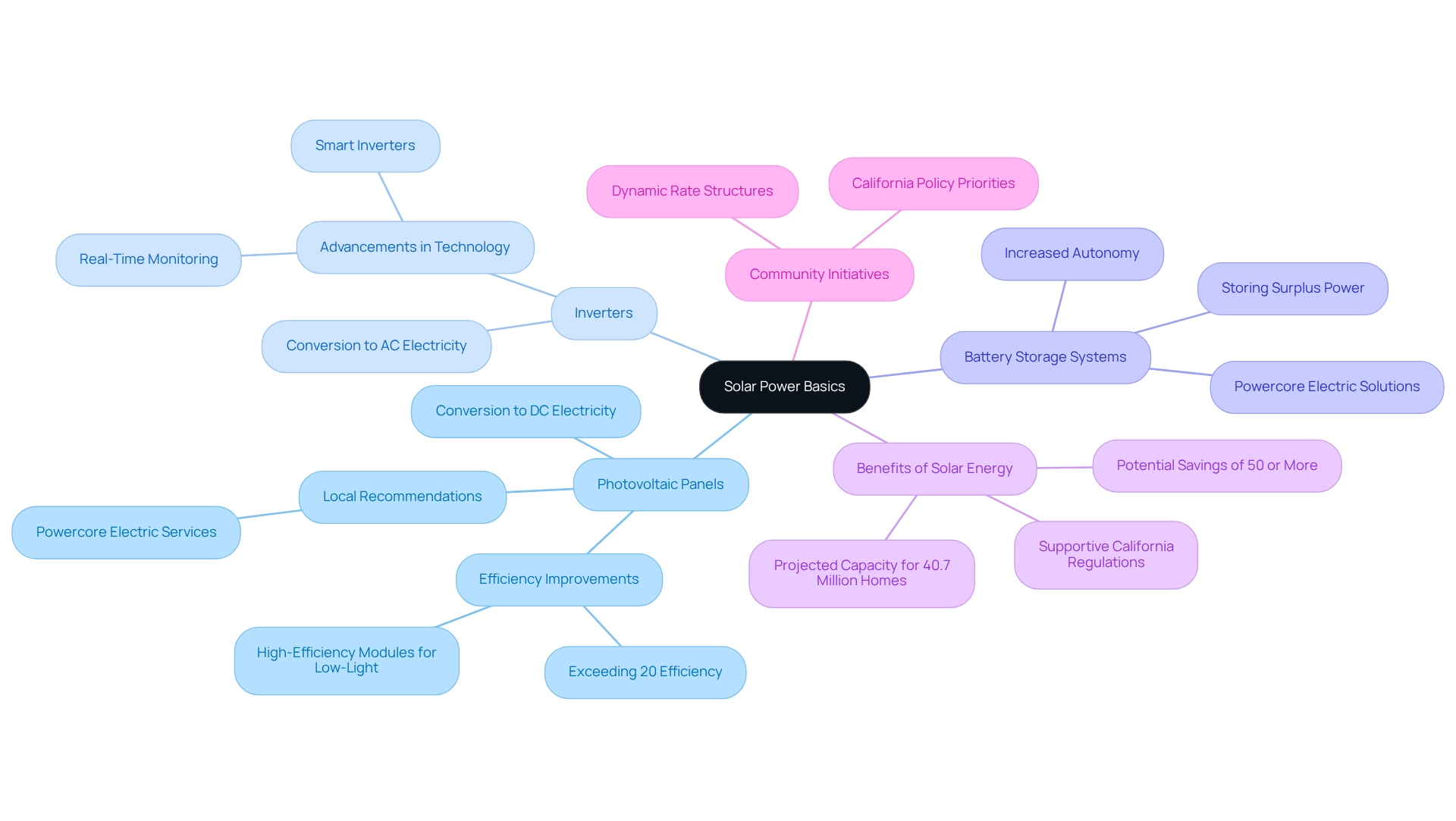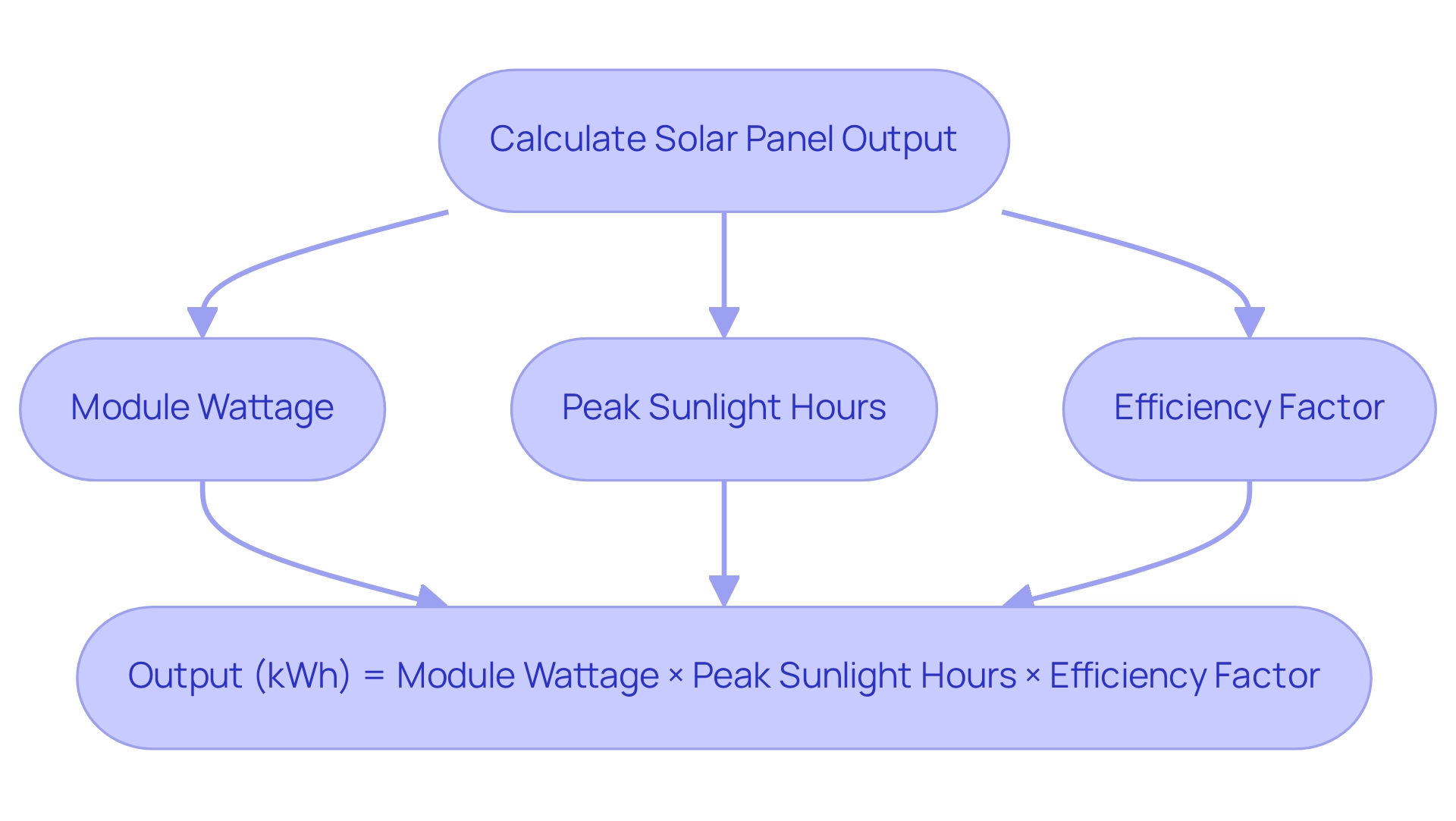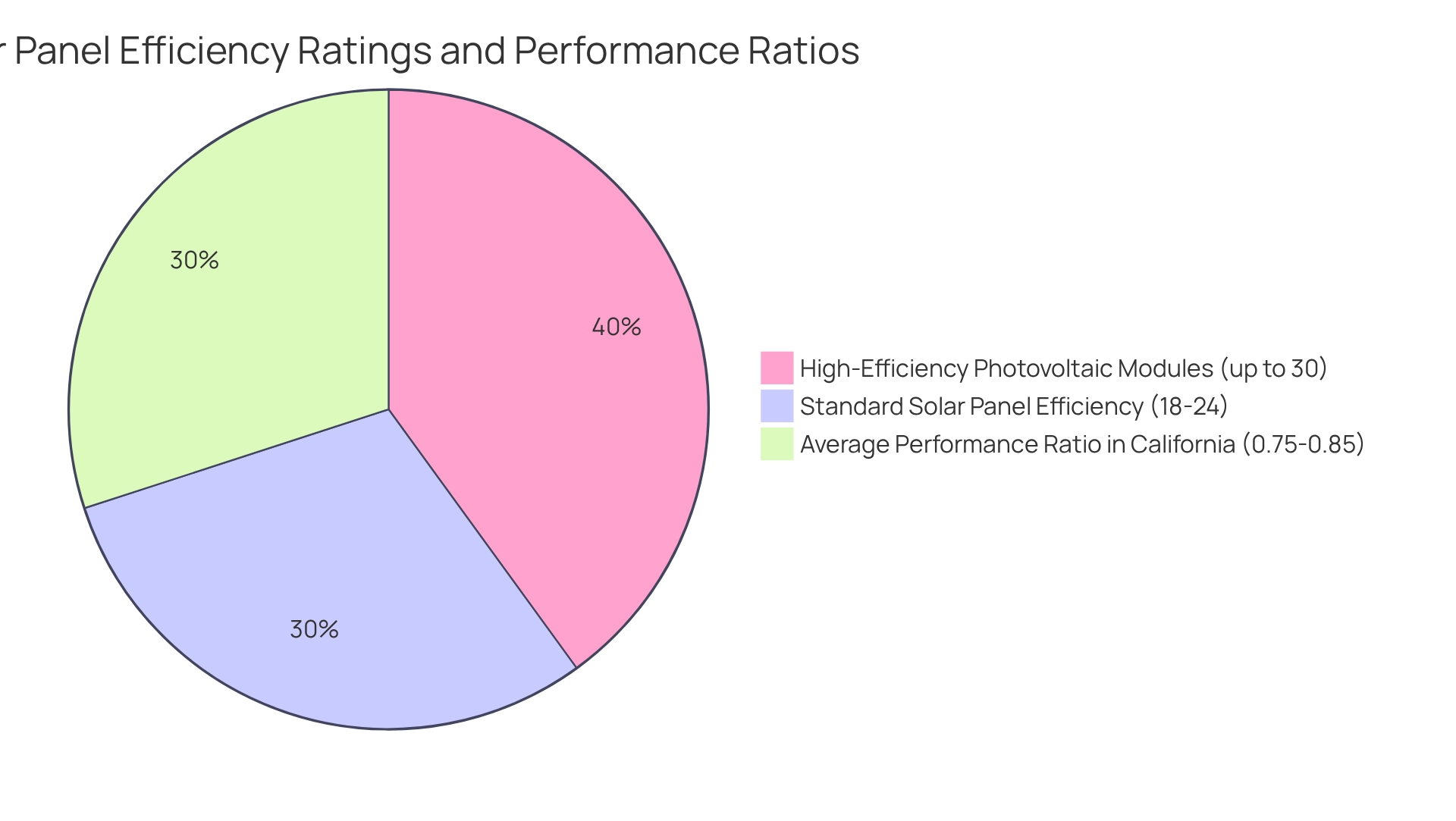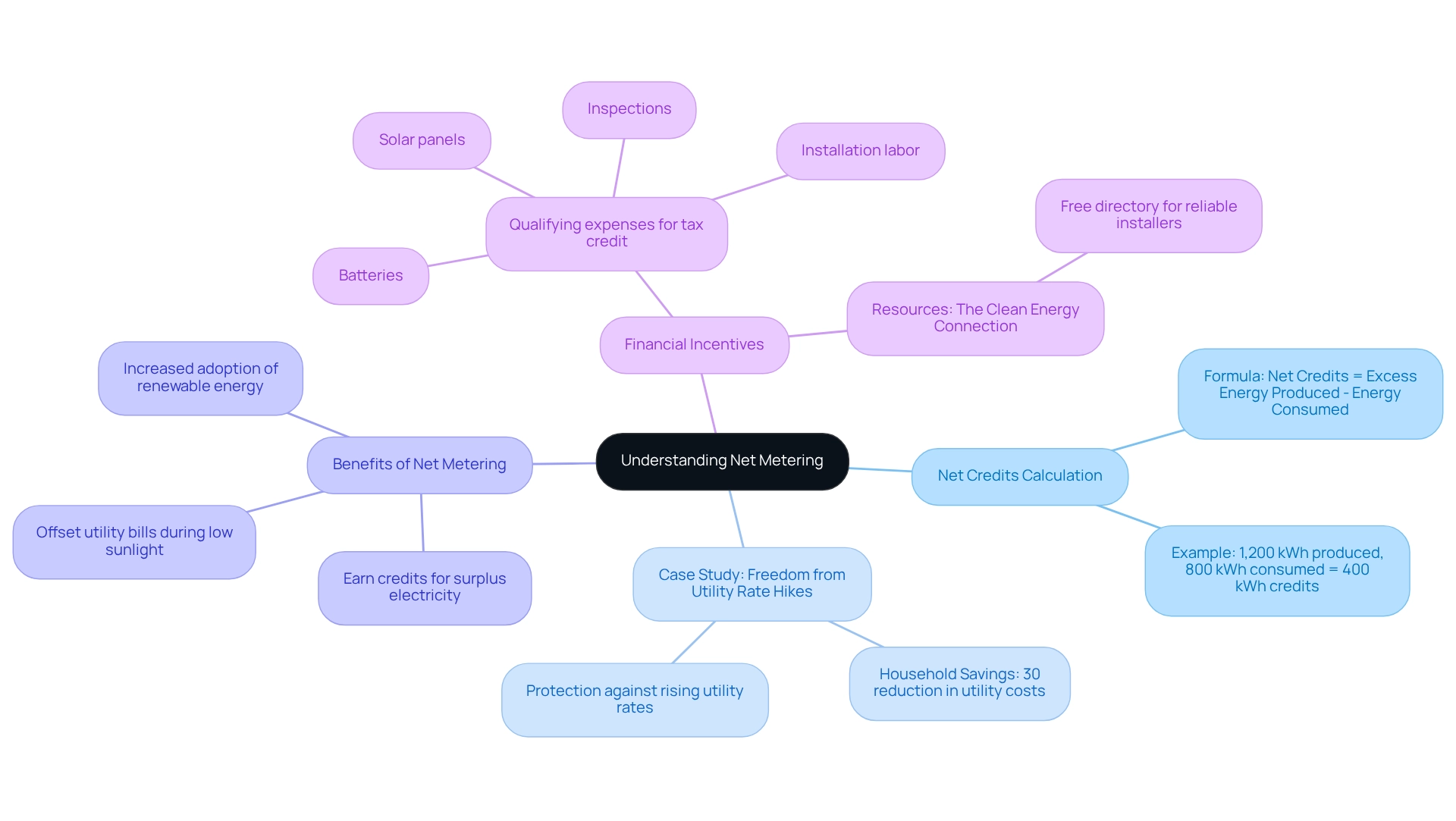Overview
This article highlights essential solar power formulas that eco-conscious homeowners should understand to optimize their energy generation and savings. We understand that energy bills can be a significant concern, and by mastering these formulas—such as calculating solar panel output, sizing systems, and determining savings—you can make informed decisions that enhance your energy independence and reduce electricity costs.
Imagine the peace of mind that comes from knowing you have control over your energy use. With insights into technology, efficiency metrics, and local conditions in California, together we can navigate these options. Let’s work towards a more sustainable future, where you can truly benefit from the power of the sun.
Introduction
In the quest for sustainable energy solutions, we understand that many homeowners are concerned about rising energy costs and their carbon footprint. Solar power emerges as a beacon of hope, offering not just a way to reduce expenses, but also a meaningful step towards energy independence. This article invites you to explore the fundamental aspects of solar energy—let’s delve into the core components of solar systems, including panels, inverters, and battery storage, and uncover how to calculate energy production and savings effectively.
With California leading the charge in solar adoption, you have a unique opportunity to harness the sun’s energy while benefiting from favorable policies and technological advancements. Imagine the relief of knowing that your energy bills could decrease significantly while contributing to a healthier planet. By examining efficiency metrics, sizing requirements, and financial implications of solar installations, this guide aims to equip you with the knowledge needed to make informed decisions on your journey toward renewable energy independence.
Together, we can navigate this path, ensuring you feel supported every step of the way. Let’s take this journey towards a brighter, more sustainable future.
Understanding Solar Power Basics
Are you feeling overwhelmed by rising energy bills? You’re not alone. Many homeowners share this concern, and that’s where solar power comes in. Solar energy captures power from the sun through photovoltaic (PV) cells, transforming sunlight into electricity. This conversion process relies on essential components: photovoltaic panels, inverters, and battery storage systems. Understanding how these elements interact is crucial for anyone looking to enhance their energy generation and storage capabilities with solar power formulas.
Photovoltaic Panels: These are the heart of a renewable energy system, capturing sunlight and converting it into direct current (DC) electricity. The effectiveness of photovoltaic systems has significantly improved, with many designs now exceeding 20% efficiency. This means you can produce more energy from a smaller area. If you live in a region with frequent overcast days, opting for high-efficiency modules designed to perform well in low-light conditions is vital.
At Powercore Electric, we offer a variety of photovoltaic modules tailored for such environments, ensuring optimal performance even on cloudy days. Local energy companies in Stockton, California, including Powercore Electric, can provide personalized recommendations based on your specific circumstances.
Inverters: Once solar panels generate DC electricity, inverters convert it into alternating current (AC) electricity, the standard used in homes.
Recent advancements in inverter technology have led to smarter, more efficient models that optimize power usage and monitor system performance in real-time.
Battery Storage Systems: These systems store surplus power generated during the day for use at night or during outages. As the use of power storage options rises, residents can achieve greater autonomy and reliability.
Powercore Electric provides premium battery storage solutions that ensure a steady power supply, especially during challenging weather or power failures.
The benefits of solar energy for homeowners are substantial. In 2025, it’s projected that photovoltaic capacity installed in the U.S. will be sufficient to power around 40.7 million homes, highlighting the widespread adoption of this renewable resource. Homeowners can significantly reduce their electricity expenses, with many experiencing savings of 50% or more, depending on their energy consumption and local utility rates.
Moreover, as California continues to enhance regulations that support renewable energy development, homeowners can take advantage of favorable conditions for investments. Recent case studies emphasize the importance of community energy initiatives and dynamic rate structures that further promote the adoption of renewable energy. Ongoing efforts to address dynamic rates and community renewable initiatives through California Policy Priorities are essential for boosting investments in photovoltaic systems and storage in the state.
Additionally, the dedicated team at Powercore Electric ensures high-quality installations and maintenance for photovoltaic systems and electrical needs, providing reliable service and support throughout your renewable journey.
By grasping the fundamentals of photovoltaic power and its components, you can utilize solar power formulas to make informed decisions about transitioning to sustainable sources. Together, we can contribute to a more sustainable future while enjoying the financial benefits of reduced utility costs. What are you waiting for? Let’s work towards a brighter, more sustainable tomorrow!
Calculating Solar Panel Output
As a property owner, you may often find yourself worried about rising energy bills. Understanding how to precisely determine the output of your photovoltaic modules can help alleviate those concerns. By using solar power formulas, such as:
- Output (kWh) = Module Wattage × Peak Sunlight Hours × Efficiency Factor,
you can gain clarity on how much power your system can generate. For instance, if you have a photovoltaic panel rated at 300W that receives an average of 5 peak sunlight hours daily, it would produce approximately 1.5 kWh of power each day. This knowledge is crucial for assessing how your photovoltaic system aligns with your household power usage.
In California, where renewable power constitutes around 29% of the state’s electricity production, grasping these calculations becomes even more essential. With the typical energy output in California anticipated to increase in 2025, residents can look forward to improved efficiency from their systems. The abundant peak sunlight hours in California create a favorable environment for power generation, making it vital for residents to understand how these elements contribute to their savings and sustainability objectives.
At Powercore Electric, our dedicated team of specialists is committed to ensuring high-quality installations and maintenance, which are key to maximizing your panel output and reliability. Regular upkeep not only enhances efficiency but also extends the lifespan of your photovoltaic systems, allowing you to enjoy the financial and ecological benefits of renewable resources for years to come. Our strong community focus and commitment to transparency in service further distinguish us as a trusted provider in the renewable energy sector.
As energy policy expert Ben Zientara wisely points out, “Comprehending photovoltaic output is essential for residents to make knowledgeable choices regarding their power requirements and enhance their renewable investments.” By mastering the solar power formulas for calculating photovoltaic output and selecting the best batteries for efficient power storage, you can fully harness the potential of your systems, ensuring that you achieve your objectives sustainably.
To further assist you, we encourage exploring battery systems like the Tesla Powerwall or LG Chem RESU, recognized for their efficiency and reliability in power storage. Understanding how solar systems function, including their components and installation requirements, is also crucial for optimizing their advantages. Together, we can work towards a more sustainable future, ensuring that your home benefits from the power of the sun.
Solar Panel Efficiency Metrics
Are you feeling overwhelmed by rising energy bills? You’re not alone. Many homeowners are searching for solutions to reduce their costs and promote sustainability. Solar collector efficiency is a vital element for those aiming to optimize their power generation with solar energy. It represents the percentage of sunlight transformed into usable electricity, with high-efficiency solar power formulas typically achieving ratings between 18% and 24%. In 2025, advancements in technology have led to the emergence of high-efficiency photovoltaic modules that can enhance power production by up to 30% in specific setups, particularly those utilizing bifacial photovoltaic cells.
This significant enhancement underscores the importance of choosing the right energy technology. When selecting photovoltaic modules, it’s essential to not only focus on the efficiency rating but also to consider solar power formulas that account for your overall power needs. Understanding the performance ratio—an important metric that compares the actual output of solar power formulas to their expected output—can provide valuable insights into how well your system performs in real-world conditions. In California, for instance, the average performance ratio for photovoltaic panels is expected to remain strong, typically between 0.75 and 0.85, indicating the state’s favorable climate for energy generation.
As the solar industry navigates uncertainties in 2025, including potential tariffs on imports and changes in federal funding, the importance of solar power formulas and their efficiency ratings becomes even more pronounced. Alfie Ireland, Head of Operations & Technical at Sunsave, shares that ‘Solar efficiency has improved enormously over time,’ particularly through advancements in solar power formulas that homeowners can leverage. Additionally, numerous case studies illustrate the effectiveness of sunlight-powered heaters in various residential settings.
For example, a household in Southern California experienced an impressive reduction in their utility costs—over 70%—after installing a water heating system combined with a heat exchanger. This setup not only provided significant savings but also contributed to their sustainability efforts by reducing their carbon footprint.
We encourage property owners to stay informed about the latest photovoltaic efficiency ratings and metrics, as these solar power formulas will be essential in your decision-making process. Experts emphasize that selecting high-efficiency panels is crucial for solar power formulas that not only enhance savings but also contribute to a more sustainable energy future. By prioritizing efficiency, you can ensure a wise investment in your autonomy and long-term savings, while also promoting sustainability and reducing greenhouse gas emissions.
Furthermore, investing in thermal energy systems can help you save between $400 to $600 each year on utility costs. Utilizing these systems can prevent 2 tons of carbon dioxide from being released into the atmosphere annually, which is akin to not driving a vehicle for four months. Together, we can work towards a more sustainable future while enjoying the benefits of energy independence.
Determining Solar Panel Size
To assess your photovoltaic system accurately, it’s essential to begin by reviewing your average monthly power usage, typically measured in kilowatt-hours (kWh). We understand that in California, the average household consumes around 600 kWh per month as of 2025. To determine how many solar modules you might need, you can use the following formula:
Number of Modules = Total Monthly Power Requirements / (Module Output × Peak Sunlight Hours)
For instance, if your household’s monthly power usage is 600 kWh and each solar module generates approximately 1.5 kWh daily, here’s how the calculation unfolds:
- First, calculate the total monthly output of a single module:
1.5 kWh/day × 30 days = 45 kWh/month. - Next, divide your total monthly power needs by the monthly output of one module:
600 kWh / 45 kWh = roughly 13.33 units.
Thus, you would need about 14 modules to meet your household’s energy demands. This method not only helps you understand your power requirements but also aligns with California’s commitment to sustainable resources, as the state aims for 60% of electricity transactions to come from renewable sources by 2030 and 100% by 2045.
By utilizing solar power formulas, California residents can effectively size their photovoltaic systems to capture sufficient clean energy for their needs. Additionally, partnering with a local expert like Powercore Electric can significantly enhance this process. With over 30 years of experience and a strong community focus, Powercore Electric offers personalized service and support, ensuring high-quality installations and maintenance through their dedicated in-house team of experts.
Their regional knowledge not only aids in accurately sizing photovoltaic modules but also underscores the importance of selecting the best batteries for effective power storage. This ensures that you can optimize your investment in sustainable energy solutions. As one satisfied client shared, ‘Powercore Electric changed our power usage and made the whole process effortless.’
Moreover, it’s crucial to consider potential expenses related to panel installation, which can vary based on system size and individual needs. Therefore, acquiring a tailored estimate is essential. Together, we can work towards a more sustainable future, empowering you with energy independence.
Calculating Energy Savings
Homeowners often find themselves grappling with the burden of rising electricity bills, and it’s completely understandable to seek a solution. By comparing previous electricity bills with projected power generation from photovoltaic installations, you can effectively determine your potential savings. The formula for calculating annual savings is straightforward:
Annual Savings = (Monthly Bill × 12) – (Estimated Solar Production × Local Energy Rate).
For example, if your monthly electricity charge is $100 and your renewable system generates enough power to offset $80 of that charge, you would save $240 annually. This simple calculation not only illustrates the financial benefits of transitioning to renewable energy but also empowers you to make informed choices about your energy consumption.
In California, where electricity bills are expected to rise significantly by 2025, understanding these savings becomes even more essential. With increasing utility costs driven by factors such as energy-intensive appliances, inadequate insulation, and severe weather conditions, implementing photovoltaic solutions from Powercore Electric can provide much-needed relief. As Kelly Bedrich, President and Chief Technology Officer, insightfully notes, “Investing in photovoltaic power not only decreases your electricity expenses but also enhances your energy independence during times of rising costs.”
By embracing renewable energy, you can alleviate the financial strain caused by escalating electricity prices. Furthermore, a review of state electricity expenses reveals that California’s rates are among the highest in the nation, underscoring the importance of considering renewable energy as a viable option for cost savings and long-term sustainability. Many homeowners have reported significant savings after making the switch to renewable energy, with some experiencing reductions in their electricity bills by as much as 50%.
Together, we can explore how these solutions can benefit you and your family, providing not just savings, but a more sustainable future.
Understanding Net Metering
Net metering is a vital system that empowers homeowners to earn credits for the surplus electricity generated by their solar panels and returned to the grid. We understand that on sunny days, energy production often exceeds household needs, creating an opportunity for savings. Homeowners can leverage these credits to offset their utility bills during times when sunlight is less abundant, such as on overcast days or at night.
The calculation for net metering credits is simple: Net Credits = Excess Energy Produced – Energy Consumed. For example, if a homeowner produces 1,200 kWh of excess power in a month and consumes 800 kWh, their net credits would total 400 kWh. By grasping this straightforward equation, homeowners can maximize the financial benefits of their renewable energy systems, utilizing solar power formulas effectively. As we look ahead to 2025, net metering continues to play a crucial role in making renewable energy more accessible and economically viable for residents in California.
Consider the recent case study titled “Freedom from Utility Rate Hikes,” which illustrates how a household in California, after installing photovoltaic systems through Powercore Electric, managed to reduce their monthly utility costs by an impressive 30%. This family not only experienced immediate savings but also gained a safeguard against rising utility rates, which have become increasingly prevalent. This aligns with expert insights that underscore the importance of net metering in promoting the adoption of renewable energy.
As one solar policy expert poignantly stated, “Solar panels don’t just save you money now. They also shield you from utility price hikes, which are happening more and more frequently.”
Statistics reveal that residential photovoltaic systems in California often generate excess power, allowing residents to benefit from net metering credits. Moreover, property owners can explore resources like The Clean Energy Connection, which offers a free directory connecting Californians with reliable installation professionals, ensuring that systems are properly sized for optimal performance and savings. Powercore Electric is dedicated to delivering local expertise and unparalleled quality craftsmanship, guaranteeing that every installation meets the highest standards.
Additionally, qualifying expenses for California’s renewable energy tax credit include panels, batteries, installation labor, and inspections, further emphasizing the financial advantages of these solutions for homeowners. This financial incentive serves as a compelling motivation for property owners to consider renewable energy options, especially in light of current policy changes and market dynamics. With Powercore Electric’s customer-first approach, residents can look forward to personalized service and support throughout their energy journey.
Calculating Solar Payback Period
As homeowners, we often feel the weight of rising energy bills, and understanding the payback duration for renewable energy systems can be a vital step towards alleviating those concerns. This measure helps you assess the economic feasibility of installations, allowing you to make informed decisions. The payback period is calculated by dividing the total installation expense by the yearly savings produced from the energy system, as illustrated by the formula:
Payback Period (years) = Total Cost / Annual Savings.
For instance, if a photovoltaic system costs $15,000 and leads to yearly savings of $2,500, the payback duration would be 6 years. This means that after six years, you would have recouped your initial investment through savings on your electricity bills.
In today’s climate of increasing electricity prices, which rose by an average of 6.2% from 2022 to 2023, understanding the payback period becomes even more essential. With photovoltaic systems in California typically requiring minimal upkeep—mainly occasional cleaning due to the area’s low precipitation—you can look forward to a reliable return on your investment.
Moreover, California is at the forefront of renewable energy, leading the nation in photovoltaic panel installations with enough capacity to power nearly 14 million homes. This shift towards sustainable energy solutions is not just beneficial; it’s becoming increasingly necessary. Recent changes in net metering policies underscore the importance of integrating new systems with battery storage and applying solar power formulas to maximize savings, which can significantly influence your payback period calculations. It’s important to be mindful that these changes may impact your overall financial plan regarding renewable energy investments.
Looking ahead to 2025, the average installation expenses for photovoltaic systems in California reflect the growing demand for renewable energy solutions. Exploring financing alternatives is also wise, as energy loans in California typically have an APR ranging from 4% to 8%, lasting between five and seven years, with monthly payments designed to align with your electricity expenses. Powercore Electric is here to provide expert insights on calculating the payback period for renewable energy, offering valuable guidance in understanding the long-term advantages of such investments.
As Whitney Vandiver, lead writer and content strategist at NerdWallet, wisely observes, “Interest rates, inflation, natural disasters — get notified when breaking news could affect your finances, and get expert insights to help you plan your next move.” Together, we can navigate these changes and empower ourselves towards a more sustainable and financially sound future.
Understanding Solar Panel Degradation
As homeowners, we understand the concern about rising energy bills and the long-term performance of solar photovoltaic systems. Typically, these systems experience a degradation rate of around 0.5% to 1% annually, which means that if a photovoltaic panel starts at an output of 300W, after 20 years, it may produce approximately 240W. Recognizing this gradual decline is crucial for setting realistic expectations regarding the longevity and efficiency of your solar investment.
Looking ahead to 2025, average degradation rates are expected to remain stable. Many manufacturers are now offering warranties that guarantee at least 80% efficiency after 25 years. This assurance is a testament to advancements in solar technology, leading to improved materials and manufacturing processes. While deterioration is an unavoidable aspect of solar panels, experts emphasize that the long-term performance of modern systems is becoming increasingly reliable, with many units still functioning well beyond their warranty periods.
It’s common for property owners to install photovoltaic systems primarily to reduce utility costs. However, it’s equally important to consider how degradation can affect power output over time. A recent study found that while financial savings are a significant motivator, understanding the efficiency loss over time is essential for maximizing the benefits of renewable energy. Notably, 80% of homeowners who invest in photovoltaic systems also opt for battery storage for backup power, underscoring the importance of integrating storage solutions with these systems.
The impact of panel degradation on energy generation can be significant. As panels age, their ability to convert sunlight into electricity diminishes, which can affect overall savings. Thus, it’s vital for homeowners to be mindful of these factors when making photovoltaic investments, ensuring they choose high-quality products known for their durability.
The renewable energy sector is poised for remarkable growth, with investments projected to reach £96.3 billion in 2023 and an anticipated rise to £162.1 billion by 2033. This growth not only highlights the advancements in photovoltaic technology but also reflects the increasing reliability of these systems.
In summary, understanding average degradation rates and their implications empowers homeowners to make informed decisions about their energy systems. This knowledge ultimately leads to a more sustainable and effective power solution. As Ben Zientara, a Renewable Energy Policy Analyst, notes, the future of photovoltaic installations will be shaped by ongoing advancements and market dynamics, making it essential for homeowners to stay informed. Additionally, the sustainability concerns surrounding the materials used in photovoltaic panels, particularly precious elements like silver, emphasize the need for recycling advancements in the industry. Together, we can navigate these challenges and work towards a more sustainable future.
Calculating Battery Storage Requirements
To help you navigate the complexities of battery storage needs for your photovoltaic system, it’s essential to first assess your average daily energy consumption and determine how many days you want to rely on battery power during outages. The key formula to remember is:
Battery Size (kWh) = Daily Usage (kWh) × Days of Autonomy.
For example, if your household consumes 30 kWh each day and you wish for two days of backup power, you would need a battery bank with a minimum capacity of 60 kWh. This calculation is vital to ensure that your power storage system can adequately support your needs when solar generation is not available.
Solar panels effectively transform sunlight into electricity, which can be stored in batteries for future use. In California, where the average daily power consumption for households is projected to be around 30 kWh in 2025, grasping these requirements becomes particularly crucial. This statistic holds significant weight, especially given California’s population density in coastal cities like San Francisco and Los Angeles, which results in lower overall resource usage compared to arid regions such as Arizona.
With the state’s commitment to sustainable energy practices, having sufficient battery storage not only enhances your energy independence but also mitigates the impact of rising electricity costs.
As you explore your options, consider the various types of batteries available, such as lithium-ion and lead-acid, each offering unique specifications and advantages. Experts emphasize that having adequate battery capacity is essential for homeowners looking to maximize their energy investments. As battery storage expert Hannah Bastawrose notes, ‘The appropriate battery size, when combined with solar power formulas, can significantly impact keeping your home powered during outages and enables you to fully benefit from your photovoltaic system.’
Additionally, it’s important to inform yourself about support programs offered by utility companies that can help alleviate high electricity costs, further enhancing your renewable energy investments. Programs such as rebates and tax incentives can significantly lower the initial costs associated with solar installations and battery systems. Case studies reveal that California’s coastal population density contributes to reduced overall resource usage compared to regions with harsher climates.
This trend underscores the importance of customized power solutions that consider local conditions and energy needs. By accurately calculating your battery storage requirements and understanding the types of batteries available, you can ensure you’re well-prepared for any energy challenges that may arise. Together, we can work towards a more sustainable future, ensuring your home remains a haven of comfort and efficiency.
Solar System Design Considerations
When creating a photovoltaic system, we understand that homeowners are often concerned about several essential factors that can impact their energy bills. By carefully assessing elements such as roof orientation, shading, and local climate conditions using solar power formulas, you can make informed decisions. Ideally, a south-facing roof provides the best sunlight exposure throughout the day, which is especially beneficial in Southern California. Adjusting the tilt angle of your structures can further boost efficiency, particularly when aligned with seasonal variations and latitude.
Shading is another critical factor to consider; even partial shading from trees or nearby structures can significantly reduce panel performance. Research indicates that shading can cut power output by as much as 80%, underscoring the importance of comprehensive site evaluations before installation. Additionally, it’s common to feel that installation on steep roofs can take two to four times longer, which may impact project timelines and costs.
To illustrate the impact of these design elements, imagine a homeowner who partnered with Powercore Electric to enhance their energy system. By ensuring their panels were installed on a south-facing roof with minimal shading, they experienced a substantial decrease in utility bills and increased power independence. This example highlights the importance of thoughtful photovoltaic system design in maximizing the benefits of solar power formulas, both financially and environmentally.
As energy journalist Zeeshan Hyder notes, “Grasping the intricacies of energy system design is essential for property owners aiming to optimize their investment in renewable resources.” This expert perspective reinforces the necessity for careful planning in photovoltaic installations.
Moreover, it’s essential for property owners to be aware of environmental factors that can affect energy performance. For instance, while pool heaters harness the sun’s power to warm swimming pools, wildfires and smoke can adversely impact panel efficiency. By focusing on ideal roof placement and minimizing shading, residents can develop effective solar power formulas tailored to their specific needs, resulting in significant savings and a lower carbon footprint.
Furthermore, selecting the right battery for efficient power storage is crucial. Homeowners should consider options like lithium-ion batteries, which offer high efficiency and longevity, or lead-acid batteries, which may be more affordable but could require more maintenance. By integrating the right battery choice with a well-designed solar system, you can further enhance your energy independence and sustainability. Together, we can work towards a brighter, more sustainable future.
Conclusion
We understand that many homeowners are concerned about rising energy bills and the impact they have on their finances. Harnessing solar power presents an incredible opportunity to not only reduce these costs but also contribute to a sustainable future. By understanding the essential components of solar systems—solar panels, inverters, and battery storage—you can optimize your energy production and savings. With California leading the way in solar adoption, you benefit from favorable conditions that promote renewable energy investments.
The financial advantages of solar energy are compelling. You can significantly lower your electricity bills and even earn credits through net metering for any excess energy you produce. Furthermore, by calculating your energy savings and understanding the solar payback period, you can make informed decisions regarding your investments. As technology continues to advance, the efficiency of solar panels improves, allowing for greater energy production and long-term savings.
Ultimately, transitioning to solar energy is not just a personal financial decision; it is a crucial step towards a more sustainable and environmentally friendly future. By investing in solar power, you can achieve energy independence, mitigate rising energy costs, and play a vital role in reducing your carbon footprint. Together, we can embrace solar energy as a proactive way to ensure a brighter, cleaner future for both you and the planet. Let’s work towards this sustainable solution together.












